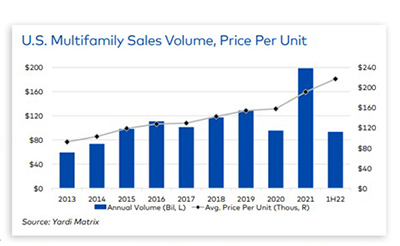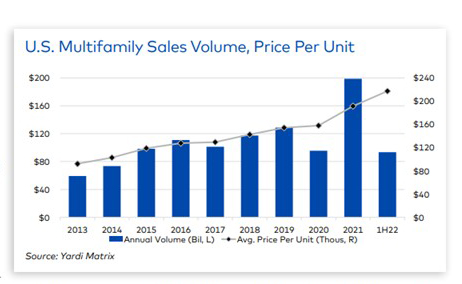
Yardi Matrix: Multifamily Outlook Hopeful Amid Volatile Economy

The multifamily market produced exceptional rent growth in the first half of 2022, driven by robust household formation, strong employment growth and households getting frozen out of homeownership, said Yardi Matrix, Santa Barbara, Calif. The sector, however, is at an inflection point as soaring inflation prompts the Federal Reserve to raise interest rates to reduce growth.
Yardi Matrix reported midway through 2022, property fundamentals continue to be “exceptional,” with rents still growing at extraordinary levels and demand still robust. The report said growth will decelerate in the second half, but the question is by how much, as persistently high inflation threatens to roil the economy.

“The economy is likewise running hot, but not without storm clouds on the horizon,” the report said. “Two years of robust job growth have put the employment market within spitting distance of its pre-pandemic level, and consumers continue to spend record amounts. But the Federal Reserve’s bid to reduce demand through rising rates and quantitative easing will cut growth, with the odds of a recession in 2023 or 2024 increasing rapidly in recent weeks.”
The report said multifamily rents have slowed from 2021’s record highs but remained at double-digit percentage growth levels through mid-year. It said pent-up demand from the pandemic has mostly receded, but it continues to be driven by robust household formation, job growth, migration to suburbs and secondary markets and the worsening affordability of single-family homes that is keeping potential first-time homebuyers in rentals.
“We expect average asking rents to increase by 7.9% by year-end,” the report said.
Yardi also noted the sector’s strong performance and the nationwide housing shortage are helping boost multifamily supply, with more than 900,000 units under construction nationally. However, “prolonged supply chain problems, rising commodity costs and reduced immigration have created material and labor shortages,” the report said. “Meanwhile, NIMBYism is increasing development costs and slowing the entitlement process, prolonging the time between project starts and deliveries. Consequently, about 420,000 units should be delivered this year.”
The report said capital conditions, a big part of the market’s success over the past decade, turned bearish in the second quarter due to rising rates and investors’ fears of a recession.
“With mortgage rates up 150 to 200 basis points, acquisition yields are rising,” the report said. “Lenders are becoming more conservative, focused on cash flow rather than income growth. Many investors and lenders are taking a step back to digest where the market is headed before they resume activity.”
But the report also noted the economic picture is “not bleak” for multifamily. “The economy added 2.2 million jobs in 2022 through June and nearly nine million since the start of 2021,” it said. “Unemployment is solid at 3.6%. Private worker wage growth has slowed somewhat but remained about 5% year-over-year as of May. Consumer balance sheets continue to be healthy. Households retain $2.7 trillion in excess savings relative to pre-pandemic, according to Moody’s Analytics. Consumer spending is still strong, surpassing the pre-pandemic trend line. Though borrowing is high, debt-service levels are low by historical standards. All these economic measures contribute to strong growth in household formation and demand for multifamily.”
